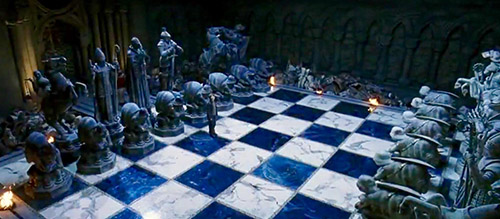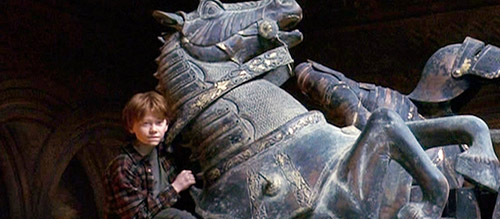Harry Potter and the Uncredited Creator of That Chess Scene
For those of you who don’t speak chess terminology, IM stands for International Master, the second highest title after GM; Grand Master. The official chess governing body, FIDE, gives out the IM title to a player who has achieved two criteria. 1) A certain rating, built up by good performance throughout dozens if not hundreds of tournaments, and hundreds if not thousands of official FIDE rated games. 2) by achieving three ‘norms’, awarded for a certain performance in tournaments where the calibre of players averages a certain level. Essentially, if you get an IM title, you’re a damn good chess player.
One such an IM is Jeremy Silman, the man uncredited with planning the chess sequence in the final act of the debut Harry Potter movie, Harry Potter and the Philosopher’s Stone (Harry Potter and the Sorcerer’s Stone to North American audiences).
The story of IM Jeremy Silman’s involvement in the Harry Potter chess scene roughly goes as follows…
When planning the chess sequence in the final act of Harry Potter and the Philosopher’s Stone, director Christopher Columbus approached Silman to ask him to design a chess puzzle that the characters would have to solve in order to advance. This would have several constraints. For example, the scene had to start with a capture of a piece from move 1 (for excitement’s sake), and not sacrifice Harry or Hermione, who stand in as pieces, or let them be captured (which would result in a grisly death and a very early end to the franchise).
Silman was apparently interested because he would have a chance to show chess correctly, and constructed a whole struggle and story within the scene through the moves played in the game. As a result, the powerful white queen became a villain, capturing a pawn and lining up an attack on Harry, and smashing a sacrificed rook which had been placed in her way. In the end, when all was said and done, Harry would be able to take the queen in the final move to win the game, symbolising the young wizard’s triumph over a powerful, anthropomorphised foe. Unlike in most representations of chess on the big screen, Silman intended Harry Potter to do the game justice, avoiding the cliché of checkmate being only one move away from a deep-thinking so-called “expert” and instead telling of a titanic struggle of sacrifice and overcoming odds, ultimately dethroning those in power; in short, a whole allegorical story within a story.
There was, however, a problem. Harry Potter and the Philosopher’s Stone’s theatrical cut was heading to a run-time of over two hours – quite lengthy for a film primarily aimed at families and children. As the film’s run-time built up, the chess scene had to be sacrificed to quicken the tempo and was therefore cut quite severely, hampering the continuity of the game, our comprehension of what actually happened on the board, and Silman’s intended allegory. What began as a carefully crafted four move puzzle (eight total game moves, four for each side), was dramatically cut down to size, even to the extent that the scene doesn’t make sense. Pieces jump around the board, the queen could still sacrifice herself to stave off checkmate for an extra move when Harry declares checkmate (thereby showing the symbolic dethroning mentioned earlier), and the rook sacrifice that is crucial to the game (by clearing a square for Harry to check the white king from) isn’t shown properly (though you do see it captured by the queen; its significance just isn’t noted). The whole scene is reduced to the pivotal moment of Ron’s sacrifice, with a montage of pieces disappearing in a shower of brick and dust beforehand.
Recommended for you: Harry Potter Movies Ranked
In the situation our heroes are faced with, there are two possible solutions to the problem; one where Harry sacrifices himself to force checkmate, and one where Ron sacrifices himself to deliver the forced, final blow. This adds greater weight to Harry’s sudden realisation that something’s wrong on the board (he realises that there are two sacrifices available), and to Ron telling Harry that it’s Harry who has to go on to get the philosopher’s stone from Snape, and not him. All of this is, of course, lost in the final cut of the film. The final scene is thrilling, certainly, and Williams’ score is typically powerful (especially in the moment of Ron’s sacrifice where he draws inspiration from his own work on Jaws), making the moment incredibly tense and climactic, but for anyone wanting to actually follow the game, well… better luck next time.
Whilst this all must be very disgruntling to Silman, who had apparently spent days crafting this symbolic story-within-a-story, the real kick in the teeth is that he isn’t even listed in the credits. All of that work – the crafting of an allegorical power struggle and overthrowing of the villain through a series of chess moves which might have gone right over the kids’ heads anyway – dismissed on screen and in the credits, as if his involvement never existed.
Warner Bros recently dedicated themselves to releasing the Snyder Cut of Justice League (set for 2021), so why don’t we let this be a heartfelt plea for the studio to #ReleasetheSilmanCut? That way, Silman’s beautiful combination may one day be seen and appreciated the way he and director Columbus had always intended.
If you would like a video explaining the basics of the story, this one from YouTube Chess is available:
Article by Kieran Judge
Twitter: @kjudgemental
Recommended for you: 10 Scariest Harry Potter Movie Moments



